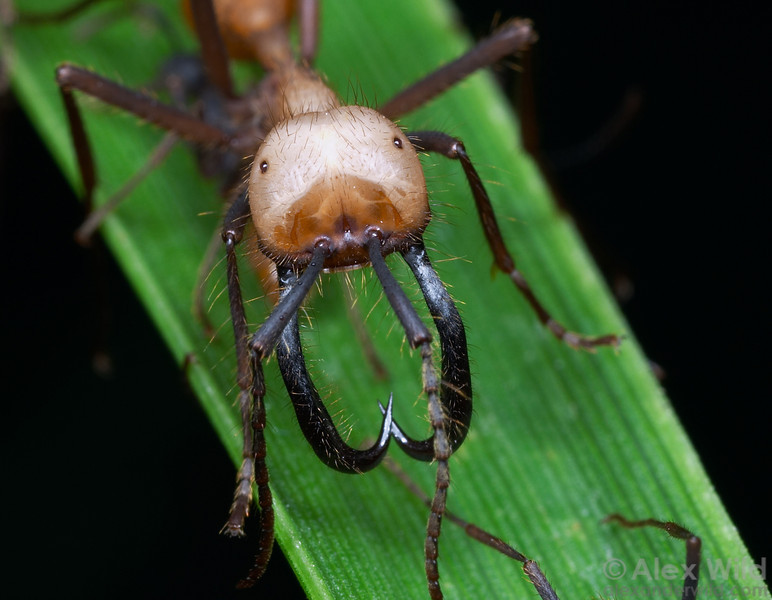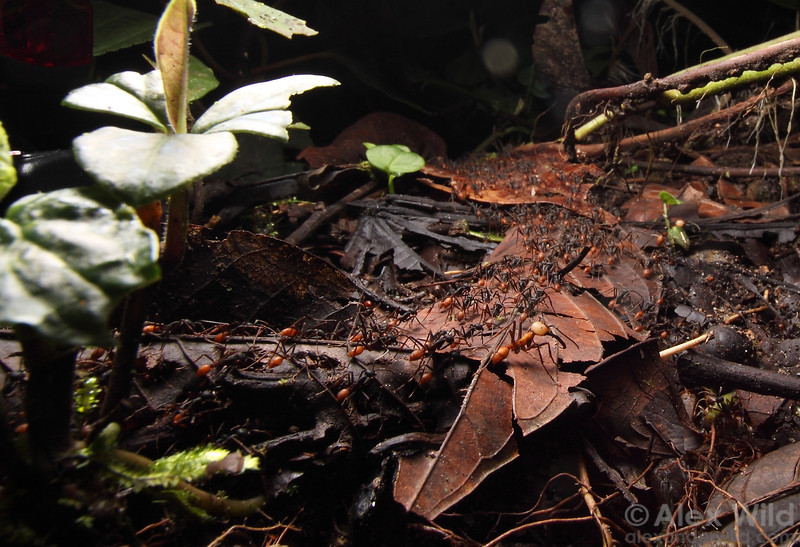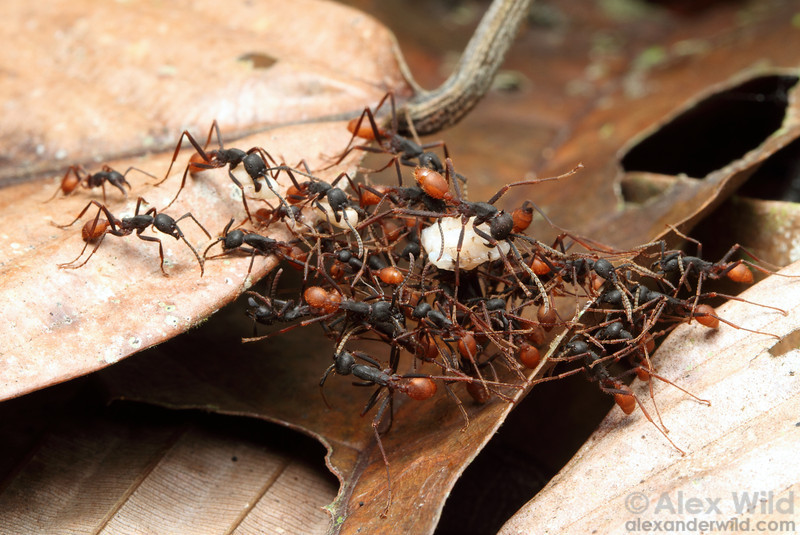Form and Function
Eciton burchellii is the commonly referred ant when dealing
with the species Eciton (Army Ants). It is the largest and most
expansive species of Army Ant. They can range in color from a
deep golden color to dull brown. (Animal
Diversity 2012). One major characteristic that one can
easily point out are their enormous numbers and swarm raiding
ventures (Amateur
Entomologists’ Society 2013). This species is distinguished
normally by its long, pointed, mandibles.

They use these hook-shaped mandibles
along with hooks on their
feet to do a
number of various functions from killing prey
to
gripping and hooking their bodies together
and forming bridges
and bivouacs (Animal
Diversity 2012). Each colony of E. burchellii
are consisted of one permanently wingless
queen and four type of workers (Wildscreen
2013). There are enormous numbers in this
species of ant
that make up each and every
colony averaging around 500,000
worker
(Franks 1989, Meisel 2006, Garnier et. al. 2012,
Pawnation 2012).
The workers in the colony make up four types of castes. The smallest of the two
castes are known as ‘minims’ and ‘mediums’. These castes
configure smaller groups to collect prey items. The next larger
caste are specialized to use their long legs and mount prey
organisms below their bodies. These ants are from the ‘porter’
caste. The largest of of the Army Ant worker castes are known as
the ‘majors’. These Army Ants use dangerous mandibles to defend
the colony from invaders (Wildscreen
2013).
E. burchellii are a very interesting ant to look into
when learning about communication skills. They have many ways to
communicate! Their most important way of communication is by
chemical signals. These chemicals are called pheromones which
can be released into the air for a number of different
situations. They can be used to signal for recognition of a nest
mate, food, alarm, and sexual communication (Animal
Diversity 2012).Workers in the colonies also use chemicals
to mark foraging trails in which others can follow. They do this
by wiping or smearing these chemicals on parts of the habitat
with their abdomens as they walk (Animal
Diversity 2012,
Pawnation 2012). Army Ants have other ways of communication (Pawnation
2012). As stated by Nigel R. Franks in his article Army
Ants: A Collective Intelligence, “Through communication and mass
action, army ants find flexible solutions to complex problems.”
One different way that Army Ants communicate are with touch and
vibrations . Workers within the colony do not communicate
visually. This reason is due to the fact that they are almost
completely blind (Animal
Diversity 2012)! These roles of the workers show some of the
limits of self-organization mechanisms in our world today
(Deneubourg et. al 1989).

These ants are able to adapt to their surrounding environments
and have a great understanding about what their roles in the
colony are. They have enormous capacities and their degree of
intelligence is overwhelming (Deneubourg et. al 1989). As stated
on the interactions page,
army ants use large numbers and swarms called raids to prey on
their food. They are well-equipped for killing prey besides the
aspect of having large numbers to swarm. Army ants have
distinctly large mandibles and stingers, which they use to
overwhelm their prey when they swarm. They use these mandibles
and stingers to overwhelm their prey with bites and stings.
These ants either eat their prey on-site or rip it to shreds.
Then they carry any leftover pieces back to the temporary
nest (bivouac) to share with the group (Pawnation
2012).
One aspect that is unique to this species of army ant is there
ability to adapt to their environment when a crisis may hit a
raid they are on. Each worker ant is approximately only 1cm
long. When on a raid for food and survival they have networking
trails that can extend over 100 m (Pawnation
2012,
Animal Diversity 2012,
Ame tur Entemologists’ Society 2013,
Garnier et. al. 2013). They
are extremely versatile and can keep
tur Entemologists’ Society 2013,
Garnier et. al. 2013). They
are extremely versatile and can keep
speeds of up to 13 cm/s
even when carrying prey items
(Garnier et. al. 2013). When living in
unpredictable and
irregular terrain, these ants are able to
overcome many
issues and problems that other species of ants may
have.
E. burchellii need to keep up the high rate of traffic
flow in
order for the colony to get sufficient food
survive (Garnier et. al. 2013). These ants have an extremely important way of modifying their environment by using their own bodies.
When approaching uneven terrain like gaps, holes, and
overhanging gaps, they link their legs together with the tarsal
claws they have. This then allows for traffic flow to keep going
and maintain speed over the linked ants bodies (Garnier et.
al. 2013).
Now for some Fun Facts!
Go back to Interactions